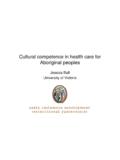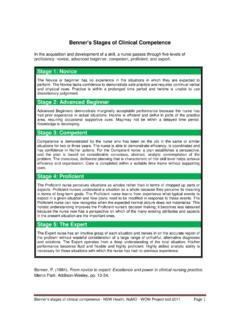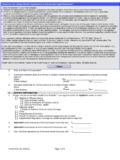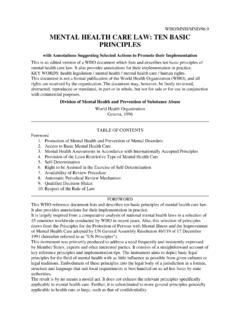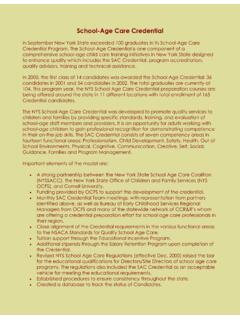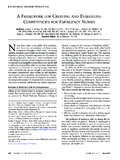Transcription of Towards a Common Language for Functioning, …
1 WHO/EIP/GPE/ : EnglishDistr.: GeneralTowardsaCommon LanguageforFunctioning, disability and HealthICFW orld health OrganizationGeneva20021 Towards aCommon LanguageforFunctioning, disability and health :ICFThe International Classificationof functioning , disability and HealthIntroduction 2 ICF and the WHO Family of Classifications 3 The need for ICF 4 How will WHO use ICE 5 How can ICF be used? 6 The Model of ICF 9 Concepts of functioning and disability10 The qualifiers11 Underlying principles of ICF14 The Domains of ICF15 Conclusion19 The World-Wide ICF Network202 INTRODUCTIONThe International Classification of functioning , disability and health , knownmore commonly as ICF, provides a standard Language and framework for thedescription of health and health -related states.
2 Like the first version publishedby the World health Organization for trial purposes in 1980, ICF is a multi-purpose classification intended for a wide range of uses in different sectors. It isa classification of health and health -related domains -- domains that help us todescribe changes in body function and structure, what a person with a healthcondition can do in a standard environment (their level of capacity), as well aswhat they actually do in their usual environment (their level of performance).These domains are classified from body, individual and societal perspectives bymeans of two lists: a list of body functions and structure, and a list of domains ofactivity and participation.
3 In ICF, the term functioning refers to all bodyfunctions, activities and participation, while disability is similarly an umbrellaterm for impairments, activity limitations and participation restrictions. ICF alsolists environmental factors that interact with all these is WHO's framework for health and disability . It is the conceptual basis forthe definition, measurement and policy formulations for health and disability . Itis a universal classification of disability and health for use in health and health -related sectors. ICF therefore looks like a simple health classifiation, but it canbe used for a number of purposes.
4 The most important is as a planning and policytool for decision-makers. 3 ICF is named as it is because of its stress is on health and functioning , ratherthan on disability . Previously, disability began where health ended; once youwere disabled, you where in a separate category. We want to get away from thiskind of thinking. We want to make ICF a tool for measuring functioning insociety, no matter what the reason for one's impairments. So it becomes a muchmore versatile tool with a much broader area of use than a traditionalclassification of health and is a radical shift.
5 From emphasizing people's disabilities, we now focus ontheir level of puts the notions of health and disability in a new light. It acknowledgesthat every human being can experience a decrement in health and therebyexperience some disability . This is not something that happens to only a minorityof humanity. ICF thus mainstreams the experience of disability and recognisesit as a universal human experience. By shifting the focus from cause to impact itplaces all health conditions on an equal footing allowing them to be comparedusing a Common metric the ruler of health and WHO FAMILY OF INTERNATIONAL CLASSIFICATIONSICF belongs to the WHO family of international classifications, the best knownmember of which is the ICD-10 (the International Statistical Classification ofDiseases and Related health Problems).
6 ICD-10 gives users an etiologicalframework for the classification, by diagnosis, of diseases, disorders and otherhealth conditions. By contrast, ICF classifies functioning and disabilityassociated with health conditions. The ICD-10 and ICF are thereforecomplementary, and users are encouraged to use them together to create abroader and more meaningful picture of the experience of health of individualsand populations. Information on mortality (provided by ICD-10) andinformation about health and health -related outcomes (provided by ICF) can becombined in summary measures of population short, ICD-10 is mainly used to classify causes of death, but ICF Family of International Classifications4 THE NEED FOR ICFS tudies show that diagnosis alone does not predict service needs, length ofhospitalization, level of care or functional outcomes.
7 Nor is the presence of adisease or disorder an accurate predictor of receipt of disability benefits, workperformance, return to work potential, or likelihood of social integration. Thismeans that if we use a medical classification of diagnoses alone we will not havethe information we need for health planning and management purposes. What welack is data about levels of functioning and disability . ICF makes it possible tocollect those vital data in a consistent and internationally comparable basic public health purposes, including the determine the overall health ofpopulations, the prevalence and incidence of non-fatal health outcomes, and tomeasure health care needs and the performance and effectiveness of health caresystems, we need reliable and comparable data on the health of individuals andpopulations.
8 ICF provides the framework and classification system for some time, there has been a shift in the focus from hospital-based acute careto community-based long-term services for chronic conditions. Social welfareagencies have noticed a marked increased in demand for disability trends have underscored the need for reliable and valid disability provides the basis for identifying kinds and levels of disability whichprovides the foundations for country-level disability data to inform policy Interventions ProceduresReasons forencounterINDN omenclatureof DiseasesPrimary careadaptationsSpecialityadaptationsICD- 10 InternationalStatisticsClassification ofDiseases & RelatedHealth ProblemsICFI nternationalClassification ofFunctioning.
9 disability and is also an increased recognition among social planners and serviceagencies that reductions in the incidence and severity of disability in a populationcan be brought about both by enhancing the functional capacity of the person andby improving performance by modifying features of the social and physicalenvironment. To analyze the impact of these different interventions, we need away of classifying domains of areas of life as well as the environmental factorsthat improve performance. ICF allows us to record this WILL WHO USE ICF?WHO must provide tools that our Member States can use to improve their healthpolicies, achieve better health for their population and to ensure that their healthsystems are as cost effective and fair as possible.
10 We provide tools that are basedon the best science and which represent the basic core values on which theOrganization bases its work: equity, inclusion and the aim of all to achieve a lifewhere each person can exploit his or her opportunities to the fullest year, the 191 Member States of the World health Organization agreed toadopt ICF as the basis for the scientific standardization of data on health anddisability world-wide. ICF directly contributes to WHO's efforts to establish acomprehensive population health measurement framework. We would like to gobeyond the old, traditional mortality and morbidity measures by includingmeasures of functional domains of uses a multi-dimensional health measure as the basis for health systemsperformance assessment.










